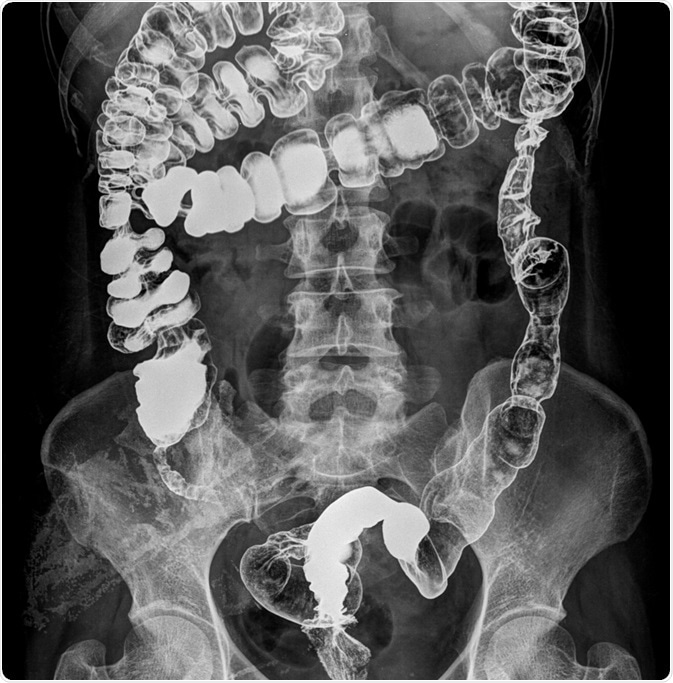Early achievements in ingestible electronics
The health of the human gastrointestinal (GI) tract is related to the development of a number of diseases and illnesses. Increasingly, gut health is being viewed as essential to overall health, which has led scientists and physicians to investigate the gut more and more.

Image Credit: Xray Computer/Shutterstock.com
In the 1950s, the first generation of ingestible electronics was developed, and scientists conducted studies that demonstrated that they could be used to measure pressure, temperature, and pH in the GI tract.
Since then, progress has been slow in developing ingestible electronics, with the first commercially available ingestible temperature sensors emerging in the late 1980s.
While slow, advancements in ingestible technologies have continued due to the potential value that stands to be unlocked. The GI tract is within close proximity to the body’s major organs. In addition, the study of the GI tract itself can serve as a marker of numerous diseases.
Therefore, ingestible electronics that can explore the GI tract could be used as diagnostic and therapeutic tools.
The PillCam was the first major breakthrough in this kind of technology. Launched in 2000, the PillCam offered an alternative method of analyzing the small intestine, which up until this point, had required invasive and complex endoscopic procedures.
The success of this product worldwide inspired a new generation of scientists to continue pushing advancements in ingestible electronics. Below we discuss the clinical applications of ingestible electronics that have arisen.
Clinical applications
Capsule endoscopy
Capsule endoscopes are often used to investigate inflammatory bowel disease. They have been widely adopted as an alternative to conventional endoscopy techniques. Regular capsule endoscopes contain high- resolution cameras, microcontrollers, silver oxide batteries, antennas, and light-emitting diodes (LEDs). The capsules have enough power to transmit videos of the GI tract for up to 12 hours, which can be then analyzed by a gastroenterologist.
Digital compliance management
Around 20-50% of people in the US do not adhere to treatment plans for chronic illnesses. Scientists have developed a method for monitoring adherence by attaching a small radio-frequency identification (RFID) chip to oral drug products, helping medical professionals to track adherence and make adjustments to plans accordingly.
Temperature, pH and pressure sensors
Biomarkers such as the pH of the GI tract, temperature, and pressure can be measured by ingestible electronics. The SmartPill is an electronic capsule that can measure these factors. It has been used to diagnose gastroparesis by measuring gastric emptying time, a key factor of this illness. This type of ingestible is not new because athletes, firefighters, and soldiers have used these devices to measure core temperature for decades.
Monitoring biomarkers
Several biomarkers present in the GI tract, including small molecules, protein, electrolytes, physiological gases, and DNA can potentially be used to assess health and disease states in real-time. Ingestible electronics with specific and sensitive sensing elements can be used to characterize compounds in complex biofluids.
Tissue evaluation
A new breed of ingestible electronics has been developed to create X-rays of the GI tract. These devices work by emitting and detecting 2D X-ray beams as they move through the GI tract. Studies have already shown that these devices could be successful in diagnosing oesophageal disease as well as measuring the severity of the symptoms of Crohn’s disease.
Monitoring signals from other organs
The GI tract is located close to the body’s major organs. This gives researchers a great opportunity to monitor important organs through the development of ingestible electronics that move through the GI tract. Research is currently underway to explore how organs adjacent to the GI tract, such as the heart and even the prostate, could be examined through the gut. This may help create new diagnostic and explorative tools that limit invasiveness and hospital time for patients.
Drug delivery
The oral route for drug delivery is often the one preferred by patients. However, in spite of much research into improving their effectiveness and reliability, this method is still subject to issues such as low solubility, low stability or poor permeability.
One promising development that may overcome these limitations is the electronic drug delivery system. Ongoing researches are on electronically controlled devices that could release drugs once they had reached the desired location in the GI tract, ensuring their efficient delivery and overcoming the limitations of orally delivered drugs.
Last Updated: Feb 24, 2020